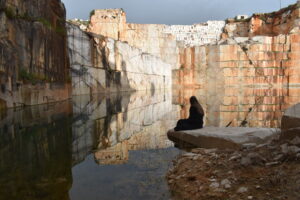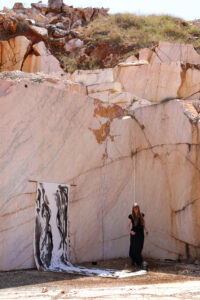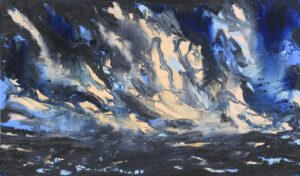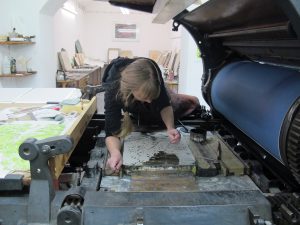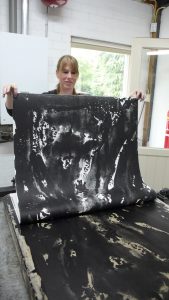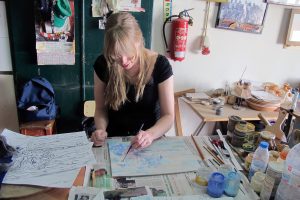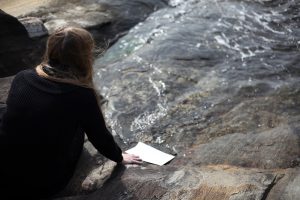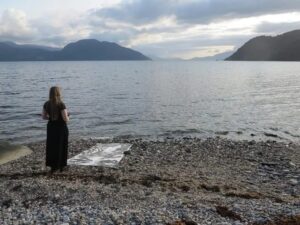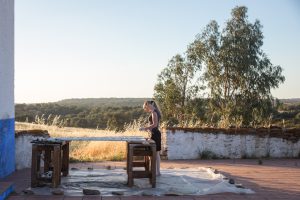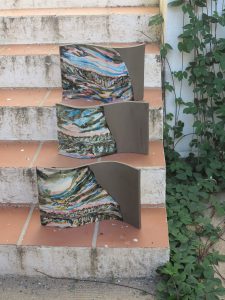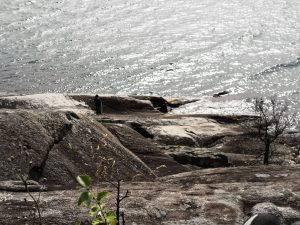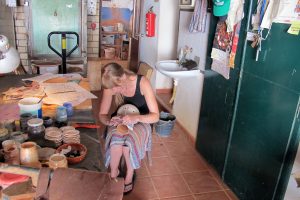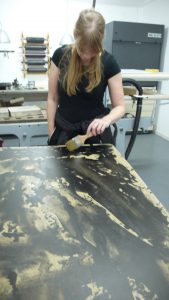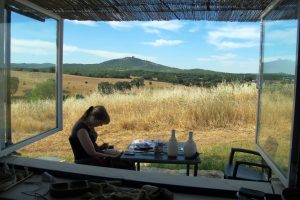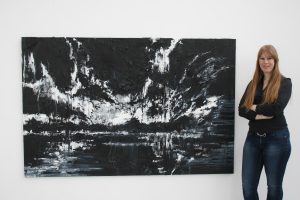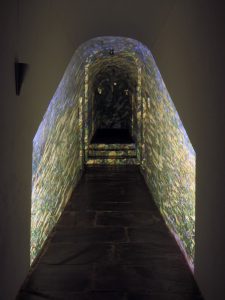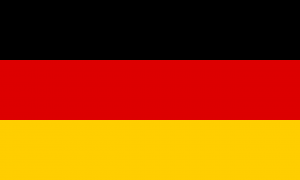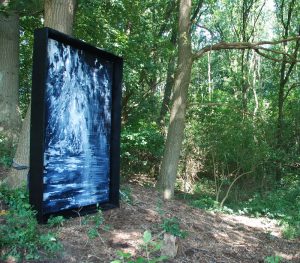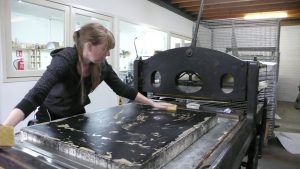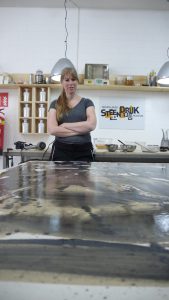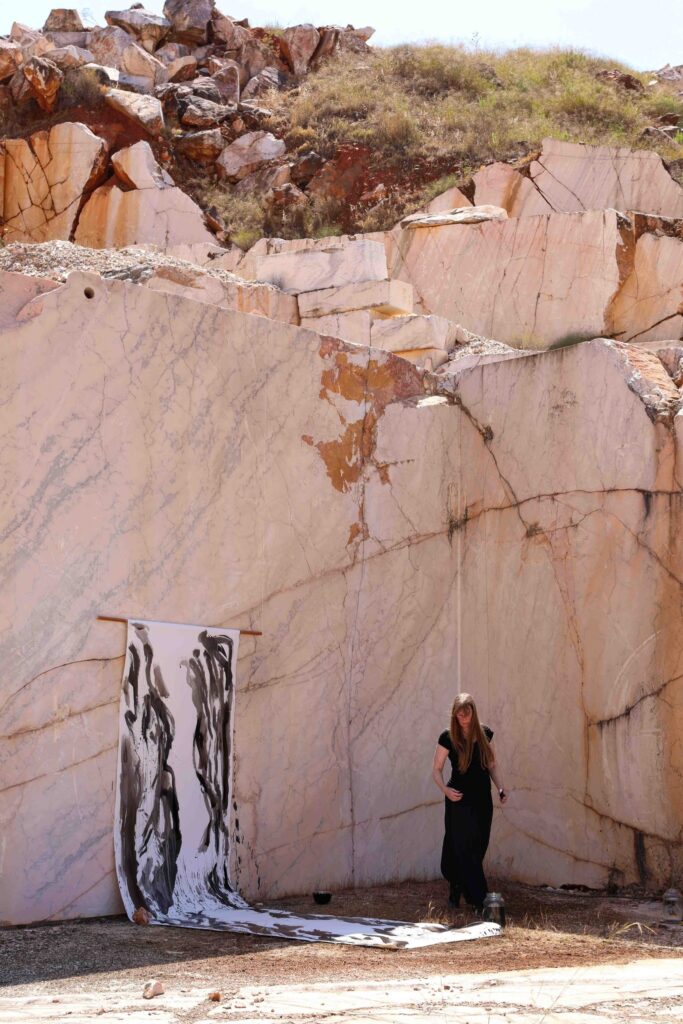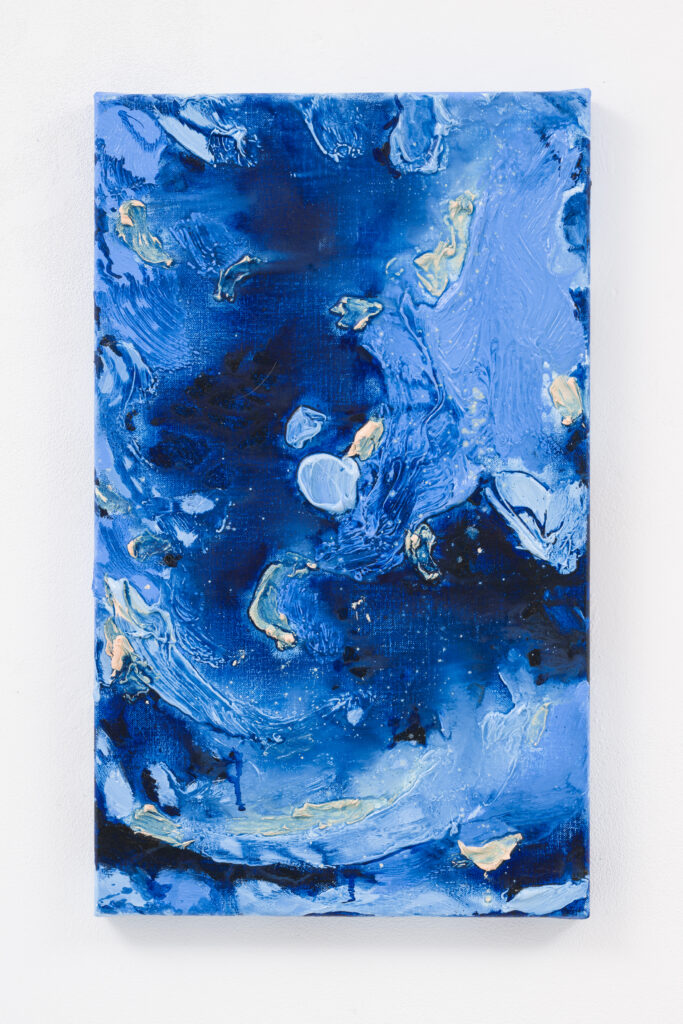Click on a flag to view your language
ARTIST STATEMENT
“Simons brings into existence things that do not exist.
It is the landscape expressing itself through her.” *
It is essential to me that both my paintings and the visual experience they catalyze, evoke a strong physical and visceral experience in the viewer, whose body is instinctively being called to ‘respond’.
My paintings are, in and of themselves, expressive spaces; their very existence depends on the physical act of painting. This act is both expressive and immensely physical, employing only pure oil paint and turpentine, wet-on-wet; aus einem Guß. My paintings contain a recognizable color palette that embodies moods and atmospheres of explosive energy and the palpable energy of the land that surrounds me.
I am Ingrid Simons, visual artist. Since graduating in 1999, I have established an active, national and international professional practice. As a starting point in my work, I use performances in which I seek connection with and in nature, always dressed in black as a “vehicle” for the performance.
Based on these performances in nature, I create abstracted, expressive and thickly layered oil paintings, inspired by my connection with nature and the connection between humans and nature. Investigating and physically experiencing these immense desolate natural landscapes and translating this into works on large-format paper on location in nature, responding directly to these locations, where I seek connection with nature and the history of the land. Working in the extreme South and North of Europe, in Portugal and in Norway, where the forces of nature are still immediately visible and tangible, has a major influence on my work.
“Simons paints invisible forces.
Her paintings are appealing because they are hiding “something”.
Some shapes are drowned out; one painting may be hidden in another painting.” *
I am interested in deconstructing the landscape and reconstructing a new physical reality from my personal experience of the land and its essence. For me, the process of painting is a physical experience, a balancing act between sculpting with oil paint and dissolving layers of paint; between building up and breaking down of structures emerging in the paint.
Through the last 25 years of my artist practice, I developed my paintings from suggestive figuratively works with human figures seen from the back in interiors and urban scapes. In the last years I am now researching more abstracted landscapes, moving towards nearly fully abstract paintings.
The protagonist is now the immense, unpolished and almost indescribable natural landscape.
The sublimity of nature and the, at times, problematic connection between humans and nature are a constant source of nourishment for the thickly layered and abstract landscapes, that show the reflective way in which I relate to the world. The exploration of abstraction, the “portrait of a form” *, the insignificance of human versus nature, the results of human presence in nature, and the attempt to capture the grandeur and omnipotent power of three-dimensional energy in nature in two dimensions — these are the recurring questions in my painting research.
Thematic series are, among others: Contemporary issues such as light pollution (for example, the “Distortion” series, Van Gogh A.i.R., 2022) in contrast to the UNESCO “Dark Sky Reserves” (the “Nebulosa” series, Southern Portugal, 2022-23). The impact of climate change on landscapes, as related to the connection between humans and nature at these various international work locations. The Berlin series: light pollution and the deserted history-filled urban landscapes intrigue and inspire me to make them visible and tangible in my work. Series inspired by painters of the past: for example – “Darkness seduce me” inspired by Barthold Jongkind in cooperation with Museum Jan Cunen, Oss, “Het Licht & Het Duister” (2017), “Nachtbloemen” and “De Nachtelijke Heide” (2022), Van Gogh A.i.R. Zundert and “Night Rises, Turrell’s Partituur”, inspired by the skyspace of James Turrell.
I am fascinated by bodies of water and their relationship to human influences: the fjords in Norway – omnipotent and unchangeable by man; the natural and man-made lakes in the Netherlands; the artificial lakes that form in the abandoned marble quarries in Portugal. Here, nature shows its strength by reclaiming its territory after human intervention. “Simons moves from the landscape, seen from afar and from the outside, from existing forms to the possibilities of the matter itself. The painter of the earth meets the land.” *
I consider myself a multidisciplinary artist, where all techniques within my oeuvre are in communion and cooperative influence. During these working periods (such as in France, Denmark, Germany) I use multiple techniques, such as ink paintings on paper in combination with performances, ceramics and graphic art (specialisms: silkscreen prints, lithography, Toyobo prints). During residencies, I explore new concepts within collaborative projects with international colleagues — such as international filmmakers, poets, and musicians. Other techniques offer new languages and solutions to artistic research questions within my work.
Artistic influences
The Japanese vision of the relationship between humans and (the experiencing of) nature is influential in my work, as is the concept of Ma and the Chinese philosophy of chi.
I draw on Dahl, Constable, Thoreaux (“True freedom is found in nature.”), Friedrich, Turner, Jongkind, Munch, Van Gogh (“I often think that the night is more alive and more richly colored than the day”), Monet, Soutine, Pollock (“The modern artist (…) expressing the energy, the motion, and other inner forces.”), Malevich (“A painted surface is a real, living form”), De Kooning, Gorky (“Abstract art enables the artist to perceive beyond the tangible, to extract the infinite out of the finite.”), Frankenthaler (“The landscapes were in my arms as I did it.”), Serra, Eliasson, Grosse and Turrell (“When we dim the light down, and the pupil opens, feelings come out of the eye like touch. Then you really can feel colour, and experience it.”).
(*) Quotes by Prof. José Rodrigues dos Santos (Évora, Portugal), “Terra da pintora da terra”.
Ingrid Simons
2024
Biography
Ingrid Simons (1976) graduated in 1999 from the Royal Academy for Art and Design, ’s-Hertogenbosch, The Netherlands. She is a visual artist: a painter working with oils on linen, a graphic artist working with lithography, silkscreen printing, photopolymer printing and ceramics (azulejos and threedimensional works inspired by local traditions). Her paintings are inspired by her performances, captured as short films, working in and in collaboration with natures’elements (since 2019).
Recently a new direction was added: works on paper, painting with ink and lacquer.
In 2005 and 2008 she was shortlisted for the Royal Award for Modern Painting; the corresponding works were shown at Museum GEM in The Hague (The Netherlands). In 2016 she received the Grant for Established Artists (Mondriaan Fonds, The Netherlands) and in 2019 she was nominated for the Berlin Prize by the ISPP International Studio & Presentation Program of Livingstone Gallery. In 2020 she was nominated for the International Senefelder Award (Germany).
Works of Simons were presented in public museums, biennials, galleries, and art fairs in countries such as The Netherlands, Portugal, Germany, Belgium, Italy, USA, Russia, and Japan.
In 2020 Simons was awarded the Brill Fellowship as an independent researcher by the Scaliger Institute of Leiden University.
Her work is represented by two galleries in the Netherlands: by Livingstone Gallery in The Hague and by Jan van Hoof Galerie in ‘s-Hertogenbosch. In 2023, Ingrid Simons presented her 8th solo exhibition in Portugal at the Museu Nacional Frei Manuel do Cenáculo, Évora (Portugal). International artist residencies include yearly residencies in Foundation Obras (Évoramonte, Portugal), bi-annual works in Berlin (Germany) and Hardangerfjord (Norway), as well as in Denmark, Germany, and France.
PERFORMANCE (2019)
“Male den sjø”
(Painting the sea)
Performance about the wish and the dream, contrasted with reality. The urge to overcome the impossible.
We see a woman in a vast fjord landscape in the South-West of Norway. The sublimity of nature is emphasized in the first and last images of the film. Slowly we draw near to a female figure on the rocky water bank. She has a white piece of paper. She starts to paint. As she paints with black ink on the white paper, nearly every stroke gets washed away by the incoming waves. Time and time again, sometimes a little bit, sometimes a lot.
The sea paints with her and against her, with its own clear water.
As she creates the painting layer by layer, the sea changes or even removes the paint immediately or a bit later, or leaves half of it behind, one shade lighter, or with almost nothing of the image left…
Painting together as one, never certain of the result, but she will always try again.
August 2019
Ålvik, Norway
Film performance at Hardangerfjord, Norway
Recording : Thursday August 15, 2019
Concept and performance : Ingrid Simons (NL)
Film and editing : Lucia Veronesi (IT)
Thanks to : Iris Blauensteiner (AT)
Loop: total 5 minutes
ARTIST STATEMENT
“Simons brengt dingen tot leven, dingen die niet bestaan.
Het is het landschap dat zichzelf via haar uitdrukt.” *
Het is voor mij essentieel dat zowel mijn schilderijen als de visuele ervaring die ze katalyseren een sterke fysieke en viscerale ervaring oproepen bij de beschouwer, wiens lichaam instinctief wordt ‘aangesproken’.
Mijn schilderijen zijn expressieve ruimtes en hun eigen bestaan hangt af van de fysieke handeling van het schilderen. In mijn olieverfschilderijen schilder ik expressief zeer fysiek, enkel met pure olieverf en terpentijn, nat-in-nat; aus einem Guß. Mijn schilderijen bevatten een herkenbaar sferisch kleurenpalet dat atmosferen van explosieve energie en de voelbare energie van het land, dat mij omringt, belichamen.
Ik ben Ingrid Simons, beeldend kunstenaar. Sinds mijn afstuderen in 1999 heb ik een actieve, nationale en internationale beroepspraktijk opgebouwd. Performances, waarin ik verbinding zoek met en in de natuur, altijd in het zwart gekleed als “vehikel” voor de performance, zijn het startpunt in mijn werk.
Gebaseerd op deze performances in de natuur maak ik abstracte, expressieve en pasteuze olieverfschilderijen, geïnspireerd door mijn verbinding met de natuur en de verbinding tussen mens en natuur. Het onderzoeken en het fysiek ervaren van deze immense, verlaten natuurlijke landschappen en het vertalen hiervan naar werken op groot formaat op papier op locatie in de natuur, direct reagerend op deze locaties, waar ik verbinding zoek met de natuur en de geschiedenis van het land. Werken in het uiterste zuiden en noorden van Europa, in Portugal en Noorwegen, waar de natuurkrachten nog direct zichtbaar en voelbaar zijn, heeft een grote invloed op mijn werk.
“Simons schildert niet-zichtbare krachten”.
Haar schilderijen zijn aantrekkelijk, omdat ze “iets” verbergen.
Sommige vormen zijn verdronken, Het ene schilderij zit misschien verborgen in het andere schilderij.” *
Ik ben geïnteresseerd in het deconstrueren van het landschap en het reconstrueren van een nieuwe, fysieke werkelijkheid van mijn persoonlijke ervaring van het land en haar essentie. Voor mij is het proces van schilderen een fysieke ervaring, een afweging tussen beeldhouwen met olieverf en het oplossen van verflagen; tussen het opbouwen en afbreken van opkomende structuren in de verf.
In de laatste 25 jaar van mijn kunstenaarspraktijk heb ik mijn schilderijen ontwikkeld vanuit het suggestief, figuratief werken met menselijke figuren die op de rug te zien zijn in interieurs en stedelijke landschappen. De laatste jaren doe ik onderzoek naar geabstraheerde landschappen, om nu (bijna) abstracte schilderijen te maken.
De hoofdrolspeler is nu het immense, ongepolijste en niet in te schalen natuurlijke landschap. De sublimiteit van de natuur en de (problematische) verbinding tussen mens en natuur is een permanente voedingsbron voor de pasteuze en abstracte scapes, die de reflectieve manier tonen waarop ik me verhoud tot de wereld.
Terugkerende onderzoeksvragen in verf zijn het onderzoeken van abstractie, het “portret van een vorm” *, de nietigheid van de mens versus nature, de resultaten van zijn aanwezigheid in de natuur en het vangen van de grootsheid en omnipotente kracht van de driedimensionale energie in de natuur in twee dimensies.
Thematische series, zoals o.a.: Hedendaagse vraagstukken zoals lichtvervuiling (bv. de “Distortion” serie, Van Gogh A.i.R., 2022) in contrast met de Unesco “Dark Sky Reserves” (de “Nebulosa” serie, Zuid-Portugal, 2022-23). Veranderende landschappen door klimaatverandering m.b.t. de verbinding van mens en natuur op deze verschillende internationale werklocaties. De Berlijn serie: lichtvervuiling en de verlaten, stedelijke landschappen beladen met geschiedenis intrigeren en inspireren mij om deze zichtbaar en tastbaar te maken in mijn werk. Series geinspireerd door schilders uit het verleden: b.v. “Darkness seduce me” geinspireerd door Barthold Jongkind in samenwerking met Museum Jan Cunen, Oss, “Het Licht en het Duister” (2017), “Nachtbloemen” en “De Nachtelijke Heide” (2022), Van Gogh A.i.R. Zundert en “Night Rises, Turrells Partituur”, geinspireerd door de skyspace van James Turrell.
Ik ben gefascineerd door waterlichamen en hun relatie met menselijke interventie: de fjorden in Noorwegen, almachtig en niet veranderbaar door de mens; de meren in Nederland, zowel natuurlijk als door de mens aangelegd; en de kunstmatige meren die ontstaan in de verlaten marmergroeven in Portugal. Hier toont de natuur haar kracht door na menselijk ingrijpen haar territorium terug te veroveren. “Simons beweegt zich vanuit het landschap, van veraf gezien en van de buitenkant, van bestaande vormen tot de mogelijkheden van de materie zelf. De schilder van de aarde ontmoet het land.” *
Ik beschouw mezelf als een multidisciplinair kunstenaar, waarbij alle technieken binnen mijn oeuvre met elkaar in gesprek zijn en elkaar beïnvloeden. Tijdens deze werkperiodes (o.a. in Frankrijk, Denemarken, Duitsland) werk ik in verschillende technieken, zoals inkt schilderingen op papier in combinatie met performances, keramiek en grafiek (specialiteiten: zeefdruk, lithografie, Toyobo print). Gedurende samenwerkingsprojecten met internationale collegae tijdens werkperiodes onderzoek ik nieuwe concepten, b.v. met internationale filmmakers, dichters en muzikanten. Andere technieken bieden andere talen en oplossingen voor schilderkunstige- en onderzoeksvragen in mijn werk.
Artistieke invloeden
De Japanse visie op de relatie tussen mens en natuur(-beleving) is invloedrijk in mijn werk, evenals het concept van Ma en de Chinese filosofie van chi. Ik put ook uit Dahl, Constable, Thoreaux (“Echte vrijheid vind je in de natuur.”), Friedrich ,Turner, Jongkind, Munch, Van Gogh (“Ik denk vaak dat de nacht levendiger en rijker gekleurd is dan de dag”), Monet, Soutine, Pollock (“De moderne kunstenaar (…) die de energie, de beweging en andere innerlijke krachten uitdrukt.”), Malevich (“Een geschilderd oppervlak is een echte, levende vorm”), De Kooning, Gorky (“Abstracte kunst stelt de kunstenaar in staat om verder te kijken dan het tastbare, om het oneindige uit het eindige te halen.”), Frankenthaler (“De landschapen waren in mijn armen terwijl ik het deed.”), Serra, Lynch, Eliasson, Grosse en Turrell (“Als we het licht dimmen en de pupil opent, komen er gevoelens uit het oog als aanraking. Dan kun je echt kleur voelen en ervaren”).
(*) Citaten van Prof. José Rodrigues dos Santos (Évora, Portugal) uit “Terra da pintora da terra”.
Ingrid Simons
2024
Bio
Ingrid Simons (1976) studeerde in 1999 af aan de Akademie voor Kunst en Vormgeving, ’s-Hertogenbosch, Nederland.
Ze is beeldend kunstenaar: een schilder, die werkt met olieverf op linnen, maar ze werkt ook in lithografie, zeefdruk, fotopolymeerdruk, keramiek. Haar schilderijen maakt ze geïnspireerd door de performances, die ze doet in en met de natuur.
Recentelijk kwam daar een nieuwe richting bij: werken op papier, schilderen met inkt en lak.
In 2005 en 2008 stond ze op de shortlist voor de Koninklijke Prijs voor Vrije Schilderkunst en deze werken waren te zien in Museum GEM in Den Haag (Nederland), in 2016 ontving ze de Werkbijdrage Bewezen talent van Mondriaan Fonds (Nederland) en in 2019 werd ze genomineerd voor de Berlin Prize door het ISPP International Studio & Presentation Program van Livingstone Gallery. In 2020 werd ze genomineerd voor de Internationale Senefelder Award (Germany).
Werken van Simons werden gepresenteerd in musea, biënnales, galeries en kunstbeurzen in o.a. Nederland, Portugal, Duitsland, België, Italië, U.S.A, Rusland en Japan. In 2020 werd het Brill Fellowship van het Scaliger Instituut van Universiteit Leiden toegekend aan Simons voor haar onderzoek in de lithografie.
Haar werk wordt vertegenwoordigd door twee galeries in Nederland, door Livingstone Gallery in Den Haag en Jan van Hoof Galerie in ‘s-Hertogenbosch.
Ingrid Simons presenteerde haar achtste solotentoonstelling in Portugal in 2023 in Museu Nacional Frei Manuel do Cenáculo, Évora (Portugal).
Naast haar jaarlijkse artistieke residenties in OBRAS-Portugal (Évoramonte, Portugal), heeft ze tweejaarlijkse werkperiodes in Berlijn (Duitsland) en Hardangerfjord (Noorwegen), naast werkperiodes in o.a. Denemarken, Duitsland en Frankrijk.
PERFORMANCE (2019)
“Male den sjø”
(Painting the sea)
Performance over de wens en de droom, die tegenover de realiteit staan. De drang om het onmogelijke te overwinnen.
We zien een vrouw in een uitgestrekte fjord in het Zuidwesten van Noorwegen. De sublimiteit van de natuur is benadrukt in de eerste en aan laatste beelden van de film. Langzaam komen we dichterbij een vrouwelijke figuur, aan de rotsige waterkant met een wit stuk papier. Ze begint te schilderen. Bijna iedere keer als ze met zwarte inkt op het witte papier schildert, wordt de schildering weggewassen door de inkomende golven. Iedere keer weer, soms een beetje, soms veel. De zee schildert met haar en tegen haar met haar eigen zuivere water.
Ze bouwt het schilderij op, de zee verandert of verwijdert de schildering onmiddellijk of een beetje later, of laat de helft staan, een tint lichter, of met bijna niets meer van het beeld zichtbaar…
Schilderen, als één, nooit zeker van het resultaat, maar ze zal het altijd opnieuw proberen.
Augustus 2019
Ålvik, Norwegen
Film performance, Hardangerfjord (NRW)
Opgenomen donderdag 15 augustus, 2019
Concept en performance : Ingrid Simons (NL)
Film en editing : Lucia Veronesi (IT)
Met dank aan : Iris Blauensteiner (AT)
Loop: 5 minuten
“Simons passa da paisagem, vista de longe e de fora, das formas existentes às possibilidades da própria matéria.
O pintor da terra encontra a terra.” *
É essencial para mim que tanto as minhas pinturas como a experiência visual que elas catalisam evoquem uma forte experiência física e visceral no espectador, cujo corpo é instintivamente “endereçado”.
Minhas pinturas são espaços expressivos que só existem através o ato físico da pintura.
Nas minhas pinturas a óleo pinto de forma expressiva e física pura e exclusivamente com tinta a óleo e terebintina, molhado sobre molhado; aus einem Guß. Minhas pinturas contêm uma paleta de cores esféricas reconhecíveis que incorporam atmosferas de energia explosiva e a energia palpável da terra que me rodeia.
Sou Ingrid Simons, artista visual. Desde que me formei em 1999, construí uma prática profissional ativa, nacional e internacional. Performances, nas quais busco a conexão com e na natureza, sempre vestida de preto como “veículo” para a performance, são o ponto de partida do meu trabalho.
Com base nessas performances na natureza, crio pinturas a óleo abstratas, expressivas e pastosas, inspiradas na minha conexão com a natureza e na conexão entre o ser humano e a natureza. Investigando e experienciando fisicamente estas imensas e desoladas paisagens naturais e traduzindo-as em trabalhos em papel de grande formato sobre locações na natureza, respondendo diretamente a estas localidades, onde procuro a ligação com a natureza e a história da terra. Trabalhar no extremo sul e norte da Europa, em Portugal e na Noruega, onde as forças da natureza ainda são imediatamente visíveis e tangíveis, tem uma grande influência no meu trabalho.
“Simons pinta as forças invisíveis.
As suas pinturas são apelativas porque escondem “alguma coisa”.
Algumas formas são afogadas, uma pintura talvez escondida em outra pintura.” *
Estou interessado em desconstruir a paisagem e reconstruir uma nova realidade física a partir da minha experiência pessoal da terra e da sua essência. Para mim, o processo de pintura é uma experiência altamente física, um ato de consideração entre esculpir com a tinta e dissolver camadas de tinta – entre a montagem e desmontagem de estruturas e padrões desta dissolução.
Nos últimos 25 anos de minha prática artística, desenvolvi minhas pinturas trabalhando de forma sugestiva e figurativa com figuras humanas vistas nas costas em interiores e paisagens urbanas. Nos últimos anos tenho pesquisado paisagens (mais) abstratas, até agora pinturas (quase) abstratas.
O protagonista é agora a imensa, bruto e quase indescritível paisagem natural.
A sublimidade da natureza e a ligação (problemática) entre o homem e a natureza é fonte permanente de alimento para as paisagens pastosas e abstratas, que mostram a forma reflexiva como me relaciono com o mundo. Questões de pesquisa recorrentes em pintura são a exploração da abstração, o “retrato de uma forma” *, a insignificância do homem versus a natureza, os resultados de sua presença na natureza e a captura da grandeza e do poder onipotente da energia tridimensional na natureza em dois dimensões.
Série temática, a.o.: Questões contemporâneas como a poluição luminosa (por exemplo, a série “Distortion”, Van Gogh A.i.R., 2022) em contraste com as “Dark Sky Reserves” da UNESCO (a série “Nebulosa”, Sul de Portugal, 2022-23). Mudança de paisagens devido às alterações climáticas no que diz respeito à ligação entre as pessoas e a natureza nestes vários locais de trabalho internacionais. A série Berlim: poluição luminosa e paisagens urbanas desertas carregadas de história intrigam-me e inspiram-me a torná-las visíveis e tangíveis no meu trabalho. Série inspirada em pintores do passado: p.e. “Darkness seduce me” inspirado por Barthold Jongkind em cooperação com Museum Jan Cunen, Oss, “Het Licht en het Duister” (2017), “Nachtbloemen” e “De Nachtelijke Heide” (2022), Van Gogh A.i.R. Zundert em “Night Rises, Turrells Partituur”, inspirado no skyspace de James Turrell.
Um ponto de foco é o meu fascínio com corpos de água e as suas relações com a intervenção humana: os fiordes da Noruega, todo-poderoso e imutável pelos humanos, os lagos na Holanda, tanto naturais como construídos por humanos; e os lagos artificiais, que surgem nas pedreiras de mármore abandonadas de Portugal, onde a natureza mostra sua força, demandando seu próprio território novamente da intervenção humana. “Simons passa da paisagem, vista de longe e de fora, das formas existentes às possibilidades da própria matéria. O pintor da terra encontra a terra.” *
Considero-me um artista multidisciplinar, onde todas as técnicas da minha obra conversam entre si e se influenciam. Durante estes períodos de trabalho (nomeadamente em França, Dinamarca, Alemanha) trabalho em diversas técnicas, como pinturas a tinta sobre papel em combinação com performances, cerâmica e artes gráficas (especialidades: serigrafia, litografia, gravuras Toyobo). Durante projetos colaborativos com colegas internacionais durante residências, exploro novos conceitos, p.e. com cineastas, poetas e músicos internacionais. Outras técnicas oferecem outras linguagens e soluções para questões pictóricas e de pesquisa dentro do meu trabalho.
Influências artísticas
A visão japonesa sobre a relação entre o homem e a natureza (experiência) é influente no meu trabalho, assim como o conceito de Ma e a filosofia chinesa do chi.
Recorro a Dahl, Constable, Thoreaux (“A verdadeira liberdade encontra-se na natureza.”), Friedrich, Turner, Jongkind, Munch, Van Gogh (“Muitas vezes penso que a noite é mais viva e mais ricamente colorida que o dia”) , Monet, Soutine, Pollock (“O artista moderno (…) expressando a energia, o movimento e outras forças internas.”), Malevich (“Uma superfície pintada é uma forma real e viva”), De Kooning, Gorky (“ A arte abstrata permite ao artista perceber além do tangível, extrair o infinito do finito.”), Frankenthaler (“As paisagens estavam em meus braços enquanto eu as fazia.”), Serra, Eliasson, Grosse e Turrell (“Quando diminuímos a intensidade da luz e a pupila se abre, as sensações saem do olho como o toque. Então você realmente pode sentir a cor e experimentá-la.”).
(*) Citações do Prof. José Rodrigues dos Santos (Évora, Portugal), “Terra da pintora da terra”.
Ingrid Simons
2024
Nota biográfica
Ingrid Simons (1976) formou-se em 1999 na Akademie voor Kunst en Vormgeving, ’s-Hertogenbosch, Holanda. Define-se principalmente como uma pintora que trabalha com tinta a óleo sobre tela, mas também como uma artista que se dedica à litografia, à serigrafia, à impressão de fotopolímeros, à cerâmica, e ocasionalmente realiza curtas-metragens e performances.
Recentemente passa a trabalhar num meio novo: pintura sobre papel em nanquim e laca.
Em 2005 e 2008 foi nomeada para o Royal Award for Modern Painting e as obras indicadas foram exibidas no Museu de Arte Contemporânea GEM em Haia (Holanda); em 2016 recebeu o Stipendium for Established Artists (Mondriaan Fonds, Holanda) e em 2019 foi nomeada para o Berlin Prize pelo ISPP International Studio & Presentation Program da Livingstone Gallery. Em 2020 foi indicada ao Prêmio Internacional Senefelder.
As obras de Ingrid Simons têm sido apresentadas em museus públicos, bienais, galerias e feiras de arte na Holanda, Portugal, Alemanha, Bélgica, Itália, EUA, Rússia e Japão.
Em Portugal esta será a sua oitava exposição individual. Na Holanda encontra-se representada por duas galerias.
Para além das residências artísticas anuais na Fundação OBRAS (Évoramonte, Portugal), fez também residências em Berlim (Alemanha) e em Hardangerfjord (Noruega), onde regressará este ano.
Desde 2010 até hoje, Ingrid Simons visita o Alentejo anualmente para uma residência artística de dois ou três meses, organizada pela Fundação Obras. Olhando para trás, este foi um ponto de viragem essencial na sua carreira de quase 25 anos como artista visual internacional.
Apaixonou-se pelo Alentejo à primeira vista desde a sua primeira residência artística. A paixão acabou por ser um amor forte e duradouro. Durante as suas residências liga-se à forte natureza alentejana e transcende esta ligação através das suas pinturas e trabalhos em cerâmica, com séries temáticas como por exemplo Nebulosa, inspirada nas noites escuras profundas e vistas da via láctea no Alentejo sem qualquer interferência luminosa e Paisagens Recuperadas inspiradas nas pedreiras de mármore e na força da natureza que as recupera do abandono. Para o seu trabalho em cerâmica, Simons começou a aprender as técnicas da cerâmica tradicional através dos ensinamentos de Mestres Xico Tarefa e Luís Rosado do Redondo, com quem trabalha em frutuosa cooperação há muitos anos.
Sandra Leandro, Diretor
Museu Nacional Frei Manuel do Cenáculo, Évora (Portugal)
“Onde cresce a esteva – A luz do Alentjo”, Ingrid Simons
Museu Nacional Frei Manuel do Cenáculo, Évora (Portugal)
22 Abril – 28 Maio 2023
Declaração de obras da cerâmica
Apesar das minhas pinturas a óleo têm prioridade, também pinto objetos de cerâmica, e azulejos que eu próprio desenhei e que são influenciadas por tradições Português e Holandês.
A ligação entre os meus obras de cerâmica e as pinturas é o ato físico com qual os trabalhos são criados. Trabalhando com a matéria, desconstruir e construir novamente, é a mesma técnica que utilizo para realizar as minhas pinturas.
Utilizando as formas cerâmicas adiciona um segmento tridimensional ao meu trabalho.
Estou curiosa sobre a influência deste segmento relativamente novo ao meu trabalho. A forma redonda do “vaso” afeta como você observa a pintura e partes desaparecem da vista. A maneira pastosa quando pinto as minhas pinturas em óleo, não pode ser usado nesta técnica. A cerâmica tem que ser pintada em camadas finas, transparentes e tem que ser construído em varias camadas. Por este abordagem desenvolvo uma técnica mais amplo de pintura.
A técnica pastosa das tintas a óleos que utiliza nas minhas pinturas, o tangível, tornou-se recentemente em cerâmica, e a pintar com barro e o tridimensionalidade dos objetos próprios. O efeito do brilho do esmalte, que permita que na mudança da posição do espectador, surge um imagem (por vezes parcialmente) diferente do pintado é um fato novo e interessante.
Como acontece na escolha da superexposição nas minhas trilhas da floresta pintadas detalhes desaparecem e surgem em formas abstratas. Isso também ocorre nos meus trabalhos de cerâmica, mas agora pinto a trilha da floresta toda e surge o desaparecimento do pintado sob a influência do brilho do esmalte.
Isto também referese ao uso de tintas metálicas ao fazer meus serigrafias.
Depois de alguns projetos em cerâmica na Holanda, comecei em 2010 em Portugal a pintar os meus primeiros azulejos com um mestre de cerâmica tradicional e local. Seguido por vasos de flores inspirados por o tradição Alentejano (Português). Todos os anos eu trabalho com ele e o filho dele. Meu trabalho cerâmica desenvolve cada vez mais em direção dos objetos de cerâmica três dimensional. Em 2020 pesquiso uma nova série tridimensional que vai ser apresentado como uma instalação.
Tudo isso afeta um ao outro e ao fazer o meu arte de cerâmica, ao mesmo tempo eu desenvolvo as minhas pinturas e minha linguagem artística.
Utilizando as técnicas mencionadas acima em combinação com as minhas pinturas em óleo proporciona uma mais-valia para o meu trabalho.
Há uma diferença visual e substantiva entre a minha arte cerâmica Holandês e Português.
Minhas cerâmicas Holandeses são fundidos. Os vasos em si são feitas a partir de moldes designadas pelo mim e a tinta é pré-misturada na fábrica, na etiqueta vê se qual cor que vai ser: tudo é melhor acabada e ajustada.
As minhas trabalhos de cerâmica de Portugal também são feito à mão, mas os azulejos são rolados de tiras grossas do barro. Os vasos são feitos à mão pelo mestre de cerâmica seguindo um esboço da minha mão. O mestre acrescenta influências tradicionais. A tinta é misturado no local e varia a cada mistura.
Já mostrei os meus trabalhos de cerâmica em várias exposições (inter)nacionais, por exemplo, na exposição individual “O azul do Alentejo, sob o meu olhar” no Museu do Artesanato e do Design em Ėvora (PT, 2015, apenas trabalhos em cerâmica), a exposição individual “O Paraiso Escondido” na Galeria Municipal D. Dinis em Estremoz (PT, 2017), o duo exposição “TERRA” no Huub Hannen Galerie (Maastricht, 2018) e a exposição individual “O Blues da Noruega” de Jan van Hoof Galerie (‘s-Hertogenbosch, 2020).
Gostaria mostrar estas disciplinas diferentes no meu trabalho com mais frequência em contexto de um com o outro.
O ano passado comecei a abordar o meu trabalho em cerâmica como objetos tridimensionais e gostaria de experimentar ainda mais, tanto no meu trabalho, como nas minhas exposições.
Ingrid Simons
2024
‘DESEMPENHO’ (2019)
“Male den sjø”
(Pintar o mar)
Um desempenho sobre o desejo e o sonho, que enfrentam a realidade. O impulso de superar o impossível.
Nós vemos uma mulher num vasto fiorde no Sudoeste da Noruega. A sublimidade da natureza é enfatizado nas primeiras e na últimas imagens do filme. Lentamente chegamos perto de uma figura feminina na margem de água rochosa com um pedaço de papel branco. Ela começa a pintar. Quase todas as vezes que ela pinta com a tinta preta no papel branco, a pintura é lavada pelas ondas que chegam. repetidamente, às vezes um pouco, às vezes muito. O mar pinta com ela e contra ela com sua própria água pura.
Ela constrói a pintura, o mar muda ou mesmo remove a tinta imediatamente ou um pouco mais tarde, ou deixa ficar a metade, com um tom mais claro, ou com quase nada da imagem visível…
Pintar, como um, nunca certeza do resultado, mas ela sempre continua a tentar.
Agosto 2019
Ålvik, Noruega
Filme de desempenho no Hardangerfjord (NRW)
Gravação quinta-feira 15 Agosto, 2019
Conceito e desempenho: Ingrid Simons (NL)
Filme e edição: Lucia Veronesi (IT)
Graças a: Iris Blauensteiner (AT)
Ciclo: o total de 5 minutes
BEGRUNDUNG
“Simons bringt Dinge ins Leben, die nicht existieren.
Es ist die Landschaft, die sich ausdruckt durch ihr.” *
Für mich ist es wichtig, dass sowohl meine Gemälde als auch das visuelle Erlebnis, das sie hervorrufen, beim Betrachter ein starkes physisches und viszerales Erlebnis hervorrufen, dessen Körper instinktiv “angesprochen“ wird.
Die Gemälde selbst sind expressieve Räume, die nur durch den physischen Akt des Malens existieren. In meinen Ölgemälden male ich ausdrucksstark und körperlich ausschließlich mit Ölfarbe und Terpentin, nass in nass; aus einem Guss. Meine Bilder enthalten eine erkennbare sphärische Farbpalette, die Atmosphären explosiver Energie und die spürbare Energie des Landes, das mich umgibt, verkörpern.
Ich bin Ingrid Simons, bildende Künstlerin. Seit meinem Abschluss im Jahr 1999 habe ich eine aktive, nationale und internationale Berufspraxis aufgebaut. Ausgangspunkt meiner Arbeit sind Performances, bei denen ich die Verbindung mit und in der Natur suche, immer in Schwarz gekleidet als “Vehikel“ für die Performance.
Basierend auf diesen Darstellungen in der Natur erschaffe ich abstrahierte, ausdrucksstarke und pastöse Ölgemälde, inspiriert von meiner Verbindung zur Natur und der Verbindung zwischen Mensch und Natur. Ich erforsche und erlebe diese riesigen, trostlosen Naturlandschaften körperlich und übertrage sie in Arbeiten auf großformatigem Papier vor Ort in der Natur. Dabei reagiere ich direkt auf diese Orte, an denen ich die Verbindung zur Natur und der Geschichte des Landes suche. Einen großen Einfluss auf meine Arbeit hat die Arbeit im äußersten Süden und Norden Europas, in Portugal und Norwegen, wo die Kräfte der Natur noch immer unmittelbar sichtbar und spürbar sind.
“Simons malt die unsichtbaren Kräfte.
Ihre Bilder sind ansprechend, weil sie “etwas“ verbergen.
Manche Formen gehen unten, ein Gemälde ist vielleicht in einem anderen Gemälde versteckt.” *
Mich interessiert die Dekonstruktion der Landschaft und die Rekonstruktion einer neuen, physischen Realität aus meiner persönlichen Erfahrung des Landes und seiner Essenz.
Für mich ist der Prozess des Malens eine sehr körperliche Erfahrung, ein Trade-off zwischen Ölbildhauerei und dem Auflösen von Farbschichten – zwischen dem Aufbau und dem Abbau von entstehenden Strukturen und Mustern aus dieser Zersetzung. In den letzten 25 Jahren meiner künstlerischen Praxis habe ich meine Gemälde aus einer suggestiv-figurativen Arbeit mit menschlichen Figuren entwickelt, die auf der Rückseite in Innenräumen und städtischen Landschaften zu sehen sind. In den letzten Jahren beschäftige ich mich nun mit (mehr) abstrahierten Landschaften, bis hin zu (fast) abstrakten Gemälden.
Der Protagonist ist nun die riesige, ungeschliffene und nahezu unbeschreibliche Naturlandschaft. Die Erhabenheit der Natur und die (problematische) Verbindung zwischen Mensch und Natur sind eine ständige Nahrungsquelle für die pastösen und abstrakten Landschaften, die die reflektierte Art und Weise zeigen, wie ich mit der Welt umgehe. Wiederkehrende Forschungsfragen in der Malerei sind die Erforschung der Abstraktion, das “Porträt einer Form“ *, die Bedeutungslosigkeit des Menschen gegenüber der Natur, die Ergebnisse seiner Präsenz in der Natur und die Erfassung der Erhabenheit und allmächtigen Kraft der dreidimensionalen Energie in der Natur in zwei Teilen Maße.
Themenreihen u.a.: Zeitgenössische Themen wie Lichtverschmutzung (z. B. Die “Distortion“-Reihe, Van Gogh A.i.R., 2022) im Gegensatz zu den UNESCO “Dark Sky Reserves“ (die “Nebulosa“-Reihe, Südportugal, 2022-23). Veränderte Landschaften durch den Klimawandel hinsichtlich der Verbindung zwischen Mensch und Natur an diesen verschiedenen internationalen Arbeitsstandorten. Die Berlin-Serie: Lichtverschmutzung und die menschenleeren, geschichtsträchtigen Stadtlandschaften faszinieren und inspirieren mich, diese in meiner Arbeit sichtbar und erlebbar zu machen. Serie inspiriert von Malern der Vergangenheit: z.B. “Darkness verführt mich“, inspiriert von Barthold Jongkind in Zusammenarbeit mit Museum Jan Cunen, Oss, “Het Licht en het Duister“ (2017), “Nachtbloemen“ und „De Nachtelijke Heide“ (2022), Van Gogh A.i.R. Zundert in “Night Rises, Turrells Partituur“, inspiriert vom Himmelsraum von James Turrell.
Ich bin fasziniert von Gewässern und ihrer Beziehung zu menschlichen Eingriffen: die Fjorde in Norwegen, allmächtig und vom Menschen unveränderlich; die Seen in den Niederlanden, sowohl natürliche als auch künstlich angelegte; und die künstlichen Seen, die sich in den verlassenen Marmorsteinbrüchen in Portugal bilden. Hier zeigt die Natur ihre Stärke, indem sie nach menschlichem Eingreifen ihr Territorium zurückerobert. “Simons bewegt sich von der Landschaft, aus der Ferne und von außen gesehen, von bestehenden Formen hin zu den Möglichkeiten der Materie selbst.“ Der Maler der Erde trifft auf das Land.” *
Ich betrachte mich als einen multidisziplinären Künstler, bei dem alle Techniken in meinem Oeuvre miteinander im Dialog stehen und sich gegenseitig beeinflussen. Während dieser Arbeitsperioden (u.a. in Frankreich, Dänemark, Deutschland) arbeite ich in verschiedenen Techniken, wie Tuschemalerei auf Papier in Kombination mit Performances, Keramik und Grafik (Spezialitäten: Siebdruck, Lithographie, Toyobo-Drucke). In Kooperationsprojekten mit internationalen Kollegen während der Residenzen erforsche ich neue Konzepte, z.B. mit internationalen Filmemachern, Dichtern und Musikern. Andere Techniken bieten andere Sprachen und Lösungen für malerische und forschende Fragen innerhalb meiner Arbeit.
Künstlerische Einflüsse
Einfluss auf meine Arbeit haben die japanische Vision der Beziehung zwischen Mensch und Natur (Erfahrung), das Konzept von Ma, Dahl, Constable, Thoreaux (“Wahre Freiheit findet sich in der Natur.”), Friedrich , Turner, Jongkind, Munch, Van Gogh (“Ich denke oft, dass die Nacht lebendiger und farbenprächtiger ist als der Tag”), Monet, Soutine, Pollock (“Der moderne Künstler (…) drückt die Energie, die Bewegung und andere innere Kräfte aus.” ), Malevich (“A painted surface is a real, living form”), De Kooning, Gorky (“Abstract art enables the artist to perceive beyond the tangible, to extract the infinite out of the finite.”), Frankenthaler (“Die Landschaften waren in meinen Armen, als ich es tat Auge wie Berührung. Dann kann man Farbe wirklich fühlen und erleben.”).
(*) Zitate von Prof. José Rodrigues dos Santos (Évora, Portugal), “Terra da pintora da terra”.
Ingrid Simons
2024
Bio
Ingrid Simons (1976) graduierte 1999 an der Akademie für Kunst und Design, ‘s-Hertogenbosch, Niederlande. Sie ist in erster Linie Malerin und arbeitet mit Öl auf Leinwand, aber sie arbeitet auch mit Lithographie, Siebdruck, Photopolymerdruck, Keramik und arbeitet gelegentlich mit Kurzfilmen und Performances.
Kurzlich kam eine neue Richtung hinzu: Arbeiten auf Papier, Malen mit Tusche und Lack.
In 2005 und 2008 wurde sie für den Royal Award for Free Painting nominiert und diese Werke wurden im Museum GEM in Den Haag (Niederlande) ausgestellt. In 2016 erhielt sie den Stipend Werkbijdragen Bewezen Talent vom Mondriaan Fund (Niederlande) und 2019 sie wurde vom ISPP International Studio & Presentation Program der Livingstone Gallery für den Berlin Prize nominiert. 2020 wurde sie für den Internationalen Senefelderpreis (Deutschland) nominiert.
Simons Arbeiten wurden in Museen, Biennalen, Galerien und Kunstmessen in den Niederlanden, Portugal, Deutschland, Belgien, Italien, den USA, Russland und Japan präsentiert.
2020-21 erhielt Simons das Brill Fellowship als unabhängiger Forscher vom Scaliger Institute der Universität Leiden.
Ihre Arbeit wird von zwei Galerien in den Niederlanden vertreten, Livingstone Gallery in Den Haag und Jan van Hoof Galerie in ‘s-Hertogenbosch. Ingrid Simons präsentierte 2023 ihre achte Einzelausstellung in Portugal im Museu Nacional Frei Manuel do Cenáculo, Évora (Portugal).
‘PERFORMANCE’ (2019)
“Male den sjø”
(Das Meer malen)
Performance über den Wunsch und Traum, das versus der Realität. Der Drang, das Unmögliche zu überwinden.
Wir sehen eine Frau in einer weiten Fjordlandschaft im Südwesten Norwegens. Die Erhabenheit der Natur wird im ersten und letzten Bild des Films betont. Langsam nähern wir uns mit einem weißen Blatt Papier einer weiblichen Figur am felsigen Wasserufer. Sie beginnt zu malen. Fast jedes Mal, wenn sie mit schwarzer Tinte auf das weiße Papier malt, wird das Gemälde von den einströmenden Wellen weggespült. Immer und immer wieder, manchmal ein bisschen, manchmal viel.
Das Meer malt mit und gegen sich mit seinem eigenen klaren Wasser.
Sie baut das Bild auf, das Meer verändert die Farbe oder entfernt sie sogar sofort oder etwas später, oder sie lässt die Hälfte davon zurück, eine Nuance heller, oder fast nichts vom Bild bleibt übrig …
Gemeinsam malen, nie sicher sein, was das Ergebnis sein wird, aber sie wird es immer wieder versuchen.
August 2019
Ålvik, Norwegen
Filmaufführung am Hardangerfjord
Aufnahme Donnerstag, 15. August 2019
Konzept und Performance: Ingrid Simons (NL)
Film und Schnitt: Lucia Veronesi (IT)
Dank an: Iris Blauensteiner (AT)
Filmloop: insgesamt 5 Minuten

